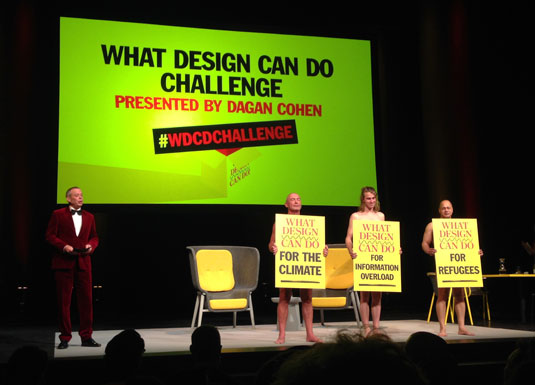5 challenges when designing for good
Want your design work to make a genuine difference? Michael Johnson reveals how to clear the necessary hurdles.
As its name implies, Amsterdam’s What Design Can Do has a noble remit: exploring how design in all its forms can help address the great issues of our time.
To mark its fifth year, the conference posed an open challenge to its delegates and the design community at large to explore how design can help address complex issues such as climate change, information overload, refugees and more.

The theme ran through many of the talks during the two-day event – including triple Brand Impact Award-winner Michael Johnson, who has spent more than a decade building a niche of 'designing for good' through his studio johnson banks, which specialises in smart, simple branding solutions for charities, not-for-profits and cultural organisations.
The 2015 Brand Impact Awards are now open for entries – submit your best branding work now
While proud of the statistic that 85 per cent of johnson banks' work now falls into that category (he'd like it to be 100 per cent), Johnson is open about the fact that creating truly engaging, effective design that makes a difference isn’t easy.
Here, he shares five challenges that he’s encountered – and how to overcome them.
01. It takes time to get the ‘right’ clients
It took johnson banks over a decade to build up enough traction to do 85 per cent of its work 'for good', and there's a reason. "The design world is very self-selecting, in the client arena at least," Johnson admits.
Daily design news, reviews, how-tos and more, as picked by the editors.
"For years we've been interested in NGOs, ethical investment, education, and culture. You can't get a project in any of those sectors, really, without having already done something in that sector. So it's unsurprising that there are specialists."

Catch-22: to get your foot in the door, you need to have done a great piece of work for a similar client. johnson banks' breakthrough project was Shelter: "I'm sure we lost money on it, but 11 years ago it showed the sector that you could do identity well. It didn't need to be just a logo stuck in the corner."
"We immediately got projects because of Shelter: it led directly to Christian Aid, and then Save The Children, and then Anthony Nolan," he adds. "It really spiralled."
02. Decisions are often made by committee
One of the things that Johnson misses about working with blue-chip companies is the autocracy. "They're definitely quicker at decision making than the NGO sector," he admits. "Consensus decisions can be very challenging."

This also makes the route between style and function notoriously tricky to navigate. "I'm not trying to make a case for design that isn't interesting, but the process is sometimes eye scratchingly difficult," he confesses.
"If you're doing a series of consensus decisions, it's very hard to say: 'This is the one, guys.' I tried it recently, and it didn't work. It's beholden on you to keep showing the best ideas that you can, and hoping you can get them through. As soon as a company like johnson banks starts doing dull work, we're lost."
03. Some clients actually don’t want to stand out
"When I started doing this, you used to get something called the 'me too' brief. We got that quite a lot, in the '80s," Johnson confesses. "You know: 'We want to look a bit like them.' We don't get that so much anymore, which is a huge relief."
It was encountered by johnson banks a few years back after presenting a series of ideas, only to have all of them shot down. "They hated everything. So I said, 'Sorry, we've obviously got the wrong end of the stick, we're trying to make you stand out?'"
"He said: 'We don't want to stand out. I want to look like a FTSE 100 company. And all the FTSE 100 companies have a thing, and some type next to it.' I said, 'What, you mean a symbol and some type? That’s what everyone has.' And he said, 'Yes!' At that point the project died."
04. You might not win many awards
Johnson points out that 'design for good' rarely wins big at major design awards (although D&AD's introduction of the White Pencil is clearly a strong step in the right direction).
"If you're viewing design through the prism of It's Nice That, then it's geometry and primary colours and centred, slightly clunky grotesque sans serifs. If [awards judges] are looking at 2,000 pieces of work, you can't help but fall back into a default setting where you just go: 'Oh, that's really nice.' People aren't very good at contextualising."
There are exceptions, of course: johnson banks picked up three gongs at our very own Brand Impact Awards last year.

Judged by an elite panel of designers and client-side creatives, the BIAs aim to celebrate the industry's best branding across more than 20 different market sectors – and johnson banks picked up awards for its work for Cystic Fibrosis (not-for-profit), Acumen (finance) and Brighton Dome (culture).
The 2015 Brand Impact Awards are now open for entries – submit your best branding work now
05. It's tempting to do a knee-jerk response
One of the many quotable lines from Johnson's What Design Can Do talk was "one poster doesn't change anything", in response to the proliferation of designers dipping their toes into the 'design for good' arena in a way that, to Johnson, is ultimately never going to make any real difference.

"I can't tell you how many posters I designed in the '90s. All graphic designers love posters. But once I got frustrated and wanted to do something that made an impact, I realised I was totally fooling myself. I needed to raise my game to make an impact, and apply all the things I know about proper branding."
He draws attention to three influential projects within a few years of each other – johnson banks' own Shelter identity (2004), Landor's campaign for the Young Women’s Christian Association (2005), and Wolff Olins's work for Macmillan Cancer Support (2006) – as catalysts for a new wave of 'design for good' that is, in itself, good design.
"Let's aim higher than flogging fizzy drinks and trainers," was Johnson's rousing call to arms in his WDCD talk. "Ask yourself: are you doing design that decorates, or that does good? Design really can make a difference."
Exclusive WDCD offer: two-year Computer Arts subscription for the price of one

Computer Arts has teamed up with What Design Can Do to bring you an exclusive offer. Simply sign up to a two-year subscription to Computer Arts magazine and only pay for one!

Nick has worked with world-class agencies including Wolff Olins, Taxi Studio and Vault49 on brand storytelling, tone of voice and verbal strategy for global brands such as Virgin, TikTok, and Bite Back 2030. Nick launched the Brand Impact Awards in 2013 while editor of Computer Arts, and remains chair of judges. He's written for Creative Bloq on design and branding matters since the site's launch.
